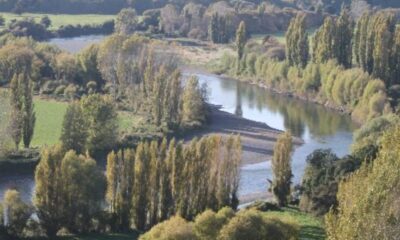Science
NASA Unveils Potential Biosignature in Mars Rock Analysis

NASA has announced a significant breakthrough in the search for extraterrestrial life, revealing a potential biosignature found in rock samples collected by its Perseverance rover on Mars. This discovery marks one of the clearest indications of possible life on the Red Planet to date.
The analysis focused on images of speckled rocks located in the ancient river delta of the Jezero Crater, a site believed to have once harbored water. The rover, which landed on Mars in February 2021, has been meticulously investigating the terrain for signs of past microbial life. According to NASA’s astrobiology team, the findings suggest that the formations could contain organic materials linked to biological processes.
Significance of the Findings
The potential biosignature is intriguing because it represents a key aspect of astrobiological research: determining if life ever existed on other planets. This discovery could reshape our understanding of Mars’ geological history and its capacity to support life. The findings are based on data collected from the rover’s advanced scientific instruments, which include a powerful camera and spectrometers that analyze mineral compositions.
Dr. Ken Farley, project scientist for the Perseverance mission, emphasized the importance of these findings: “Finding something that could be a biosignature is exciting, but we need to study it further to confirm its origins.” This statement highlights the cautious approach scientists must take when interpreting results from Mars.
The Jezero Crater, which spans approximately 45 kilometers, was chosen for exploration due to its past as a lakebed. The rover’s mission continues to explore this area, searching for additional evidence of past life and gathering data that could inform future human missions to Mars.
Next Steps in Exploration
As the Perseverance rover continues its journey, scientists will analyze more samples and images to better understand the geological processes that shaped the environment. The mission is expected to last at least until 2023, with ongoing experiments aimed at confirming whether the detected features truly represent biological activity.
Additionally, the findings could have broader implications for the search for life beyond Earth. Understanding the conditions that allowed for potential life on Mars may provide insights into similar processes occurring on exoplanets.
NASA’s commitment to exploring Mars aligns with its long-term goals of returning samples to Earth for detailed examination. The agency plans to collaborate with international partners for future missions. The excitement surrounding this potential biosignature underscores the growing interest in Mars exploration and the quest to uncover the mysteries of the universe.
In conclusion, the discovery of a potential biosignature by NASA’s Perseverance rover is a pivotal moment in the ongoing search for life on Mars. As scientists continue to analyze the data, the implications of these findings could reshape our understanding of where and how life may exist beyond our planet.
-

 World3 months ago
World3 months agoTest Your Knowledge: Take the Herald’s Afternoon Quiz Today
-

 Sports3 months ago
Sports3 months agoPM Faces Backlash from Fans During Netball Trophy Ceremony
-

 Lifestyle3 months ago
Lifestyle3 months agoDunedin Designers Win Top Award at Hokonui Fashion Event
-

 Sports3 months ago
Sports3 months agoLiam Lawson Launches New Era for Racing Bulls with Strong Start
-

 Lifestyle3 months ago
Lifestyle3 months agoDisney Fan Reveals Dress Code Tips for Park Visitors
-

 Health3 months ago
Health3 months agoWalking Faster Offers Major Health Benefits for Older Adults
-

 World3 months ago
World3 months agoCoalition Forms to Preserve Māori Wards in Hawke’s Bay
-

 Politics3 months ago
Politics3 months agoScots Rally with Humor and Music to Protest Trump’s Visit
-

 Top Stories3 months ago
Top Stories3 months agoUK and India Finalize Trade Deal to Boost Economic Ties
-

 Entertainment3 months ago
Entertainment3 months agoExperience the Excitement of ‘Chief of War’ in Oʻahu
-

 World3 months ago
World3 months agoHuntly Begins Water Pipe Flushing to Resolve Brown Water Issue
-

 Science3 months ago
Science3 months agoNew Interactive Map Reveals Wairarapa Valley’s Geological Secrets









